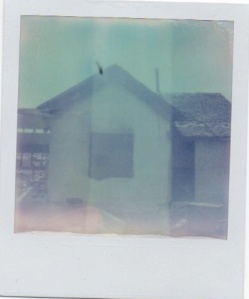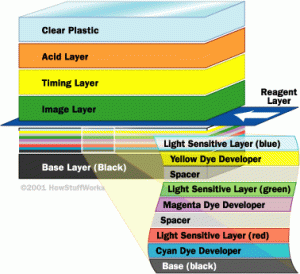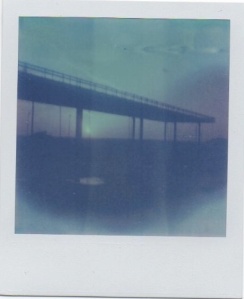POLAROID PHOTOGRAPHS::
LAYERED MEMORY//
LAYERED EMULSIONS
ferry boat on the water//port townsend, wa
Why are humans so drawn to taking and saving photographs? Polaroids in particular are an incredible and unique technology with a fascinating past, and have been saved by two men in the Netherlands, who figured out a way to continue creating and making new Polaroid film. What is the past, present, and future of Polaroid?…
— This is my version of a chapter in “Yes, Naturally, How Art Saves the World”, Niet Normaal Foundaiton
My chapter is based on Luciana Parisi’s chapter entitled: Synthetic Nature, A Nano-Technological Future—–
A BRIEF POLAROID HISTORY::
+In 1926 Edwin H. Land (the founder of Polaroid), left Harvard University and pursued his own research on light polarization. He filed for his first patent two years later for a synthetic polarizer. 1
+In 1937 the Polaroid Corporation was founded, and in 1948 the first instant film camera was available to consumers. (Initially, Polaroid sold polarized sunglasses)
+The early cameras were called ‘Land Cameras’ after the founder. 2
 ((collection of polaroid land cameras))
((collection of polaroid land cameras))
photo courtesy of: https://www.flickr.com/photos/timmythesuk/2107418291/in/pool-camerapedia/https://www.flickr.com/photos/timmythesuk/2107418291/in/pool-camerawiki
+The first camera sold was the Model 95, and it is the prototype for all Polaroid cameras for the next fifteen years.
+In 1949 after the Model 95 sold more than $5 million in camera sales, Ansel Adams was hired as a film consultant.
+In 1961 Polaroid introduced Positive/Negative 4×5 film Type 55, which was the first black and white film that produced a positive and a negative.
+Polacolor is the first instant color film invented in 1963. The Model 100 Land camera has come out, and is the first of its kind with the first fully automatic pack film with automatic exposure control, and Type 48 and 38 Polacolor Land roll films are introduced.
+The Polaroid SX-70Land Camera comes out in 1972. It is the first automatic, motorized, folding, single-lens reflex camera which makes self-developing instant prints.
(photo courtesy of:: http://notquiteinfocus.com/2014/07/22/a-brief-history-of-photography-part-9-polaroid-instant-film/+In 1976 the 20×24-inch and 40×80-inch instant cameras are created to produce high quality art reproductions for museums.)
+Edwin Land is awarded his 500th patent in 1977. The OneStep Land Camera is introduced and is inexpensive with a fixed-focus camera. It is the best-selling camera in the U.S., instant or conventional.
+1978: Polavision comes out. It is an instant color motion picture system.
+Time Zero, a faster developing film comes out in 1979, and it replaces SX-70 film.
+Land retires as CEO in 1980, and is the Consulting Director of Basic Research in Land Photography.
+1981: Sun 600 System and Type 600 color film are released.
+In 1983, Polaroid is an immensely successful company. There have been over 1,000 patents.
+1986: Federal appeals court upholds the decision that Eastman Kodak violated Polaroid patent rights in the manufacture of its instant cameras and film. The Spectra System camera is introduced. It has been 38 years since the first Land camera was announced.
+1987: It is the 50th Anniversary of Polaroid!
+Edwin Land dies at the age of 82, in 1991.
+Captiva camera and film system, which is ultra compact in format and design comes out in 1992.
+1998-1999: Digital camera sales make Polaroid the number one camera seller in the United States. The I-zone, JoyCam, and PopShots cameras are introduced.
+Polaroid files for Chapter 11 bankruptcy in 2001.
+2002: The end of an era. Polaroid is purchased by One Equity Partners, creating a new company under the Polaroid Corporation name. 4
DON’T UNDERTAKE A PROJECT UNLESS IT’S
MANIFESTLY IMPORTANT AND NEARLY IMPOSSIBLE – Edwin Land
In 2008, the founders of The Impossible Project purchased the last factory in the world manufacturing Polaroid instant film. They wanted to save 200 million Polaroid instant cameras from becoming obsolete. Two years after their start-up began producing their own re-formulated versions of classic Polaroid instant film formats. (SX-70, 600, and Image-Spectra, as well as 8×10) This, all in their plant in Enschede, in The Netherlands, and Monheim, Germany. Now The Impossible Project has over 130 employees in Austria, Germany, the Netherlands, Britain, France, the USA and China. They now produce: analog instant film, refurbished Polaroid cameras, and its own-designed range of analog instant cameras. 5
( http://www.the-impossible-project.com )
“THE ORGAN OF PERCEPTION” –Goethe
With the innovation and magic of Polaroid, what were the early users of this technology vulnerable to and what did they gain?…
Once the camera takes the photograph you know within 60 seconds whether or not your image came out the way that you conceptualized it in your mind. Once the first digital cameras were available the time spent conceptualizing an image becomes instant, and that process is no longer a labor of learning the technology and gaining a new skill, while also awaiting the results of the process. It was commonplace for a person taking a photograph in the early twentieth century to have to wait one week before getting their images back and printed on to photo-paper. Once instant cameras were invented, the waiting period was reduced down to one minute. By the 1970s Polaroid instant cameras and film were cheaper, and more readily available. 7 Edwin Land wanted to streamline his cameras and film to fit in the pocket of the user. He also wanted the experience to be for anyone of any age and of any experience level. 7
So what happens when technology takes a learning curve for a skill such as photography and makes it simplified, accessible, and instant? Do humans lose a part of the process? What happens to the time and space once spent learning how to load analog film, using a light meter, and manually focus the lens and set the aperture before even taking the photograph? Point and shoot cameras have been around for consumers for decades now, and our cell phones have become digital cameras, digital photo editors, and digital instant sharing of our photographs. Rather than spending time in the dark room, and awaiting your film strip to display whether or not you have an image, you know instantly whether or not the image you wanted to take was the outcome you imagined.
When we shed the abstract idea of preparation, a new field of questions opens up. -Criag Holdrege
In 1974, Edwin Land wrote, “A new kind of relationship between people in groups is brought into being…when the members of a group are photographing and being photographed and sharing the photographs… It turns out that buried within us…there is latent interest in each other; there is tenderness, curiosity, excitement, affection, companionability and humor…. We have a yen for and a primordial competence for a quiet good-humored delight in each other: We have a prehistoric tribal competence…in being partners in the lonely exploration of a once-empty planet.” 7
both photographs were taken on the first day of my sensory-memory journey across the South Western United States. (( Expired Polaroid SX-70 film)) The photograph on the left is at sunset at an abandoned gas station, the photograph on the right is at a Ranch outside of Dallas, Texas. There is a large lasso, cow skull, and large cactus plant resting against a fence just outside of the ranch..at the time I recall thinking, “could there be anything more quintessentially ‘Texas’ ?”
When I was on a road-trip back in 2012, I was on a Polaroid-specific photographic adventure with one of my best friends, who also shares a love for Polaroid and is herself a photographer. We purposely bought packs and packs and packs of the Impossible project’s expired SX-70 and 600 film, several compatible Polaroid cameras, and some 35mm cameras and film, just to be safe. We journeyed through the South Western United States with no real agenda, just a deadline to get from Dallas, Texas where Kendra and I met up, all the way to the Grand Canyon, and back to Atlanta, Georgia (my home((born and raised, y’all)), and at the time her home as well) within about a week. My creative project at the time through my class at Evergreen, was to use Marcel Proust’s sensory memory writings as companion texts, and create my own version of the Madeline cookie experience. I wanted to use memory and something like the unknown outcome of a polaroid photograph, to trigger my own sense of dreams, making memories, and reliving those memories through my own strange and distorted photographs. I hand-made a book, with some writing, but mostly quotes from the texts that I was reading at the time, and I juxtaposed those writings and excerpts with my own photographs…photographs that would shape the mind’s memory of events and places. The expired film photographs, like human memory, morph and fade with the passing of time.
 (expired sx-70 film) an abandoned house along the highway in new mexico
(expired sx-70 film) an abandoned house along the highway in new mexico
— Kendra and I explored around this abandoned house for quite some time. I took several photographs in three formats: expired Polaroid SX-70 film, 35mm, and with my cell phone. I wanted every texture, every shade, and the milky dreamy memory fading inside of the expired Polaroid photographs.
As Parisi writes, “It is not the same event that connects nature and culture. It is the virtuality – or abstract relationality – of an event that remains as if it were in common in an expanded experience linking nature again to its becoming and culture to its evolution.” 9
Here is a direct link to her research and staff details where she lectures at Goldsmith’s University of London :: http://www.gold.ac.uk/cultural-studies/staff/l-parisi/
I believe that my obsession with Polaroid instant camera’s and film are the connections I make with the mental image, the conceptualization of the image, and the instant material that is produced after a button is pressed on the camera. The mental to material are unparalleled with anything else in the photography world. Looking through the camera, like a bead, my mental conception of the image is then instantly produced and able to be passed around, collected, framed, thrown away, used as a bookmark, or sent on a postcard to a friend. All things become possible in the magic of an instant film photograph.
Polaroid 600 round film// this photo was taken during low tide at Priest Point Park, in Olympia, Washington. I wanted to capture the decay and soaked tree branches, weighed down from the algae that grows on their limbs during high tide. The ecological state of being from one time of day to another is truly remarkable. A different set of rules apply to the ecosystem of the trees and their roots, all depending upon the moon cycle and the tides.
The impact of instant film and cameras are incalculable to me.
Although the chemicals used to create such images are caustic and non-sustainable, their material has hardly the impact of one cell phone being crushed in a landfill, or sent to an Asian manufacturer where the employees are exposed to the toxic materials used to create smart phone screens. There will always be question to what the purpose or reason is behind creating and handling material objects. Our memories are now held within the confines of social media, text messages, and cell phone photographs. Where does nature end and where does it begin when it comes to the mental and the material? Parisi has argued, “This indicates not the disappearance of nature, but its expansion onto the atomic field of matter: inorganic nature acting back on the organic architecture of a body.” Perception and experience are always intertwined and changing what the physical, the mental, and the material of our environment represent to us. Once we interact with an object or project our object thinking outward, and thinking becomes materialized, the process changes.
.BIBLIOGRAPHY.
(a working progress, I have not completed this section, this is a mere rough draft/skeletal outline)
1. http://www.polaroid.com/history
2. http://camaerapedia.wikia.com/wiki/Polaroid
3. http://en.m.wikipedia.ord/wiki/Instant_camera
4. http://www.bu.edu/prc/forms/polatimeline.pdf
5. https://www.the-impossible-project.com/about/
6. http://en.m.wikipedia.org/wiki/Impossible_Project
7. http://notquiteinfocus.com/2014/07/22/a-brief-history-of-photography-part-9-polaroid-instant-film/
8. Thinking Like a Plant, Craig Holdrege
9. Yes Naturally, How Art Saves the World, Niet Normaal Foundation (2013, Ine Gevers, the authors, the photographers, the artists and nai010 publishers, Rotterdam)
img. 1:: grand canyon// expired Polaroid color shade 600 film// img. 2:: me in front of the Grand Canyon, shot on expired Polaroid color shade 600 film
.like a fever, like a dream.






